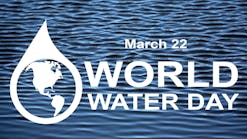Although membrane based, seawater reverse osmosis (SWRO) desalination has taken over globally from thermal technology, the use of solar power has been touted as one way to help close the gap.
Speaking in Abu Dhabi, Dr. Abdullah Al-Alshaikh, president of the International Desalination Association (IDA), said: “Perhaps thermal technology will be reinvigorated through the use of solar technology. It’s quite conceivable that solar heating is sufficient enough to run thermal processes.”
He said: “We will continue to accelerate, expand and improve the use of alternative and renewable energy sources such as wind and solar, cutting energy costs and cutting carbon emissions, making them ever more viable and attractive.”
With membrane costs going down, and efficiencies improving, SWRO desalination overtook thermal desalination between 2002 to 2012.
Membrane processes now account for more than two thirds of installed capacity.
In 2012 installed membrane capacity was 49.9 million m3/day compared to 23.2 million m3/day for thermal technologies, such as MSF (multi-stage flash) or MED (multi-effect distillation).
The IDA’s State of the Nation report in 2011 showed that out of the global 66.48 million m³/day installed capacity, RO accounted for 59.85%. MED and MSF meanwhile account for 8.20% and 25.99%, respectively.
Dr Al-Alshaikh added: “In our reach for sustainability, not only will we continue the move toward more energy efficient methods of desalination such as Reverse Osmosis, not only will we continue to perfect those methods as demonstrated through the gains in nanotechnology and nanofiltration in the past two years; there are more – many more possibilities.”
Thermal desalination processes such as MSF and MED have in the past provided the majority of potable water in regions such as the Middle East, where excess heat from power plants is used to heat and desalinate seawater.
Yet efforts are now underway to increase solar powered desalination efforts in the region.
At the end of 2013 utility company Utico Middle East invited tenders for what is being labelled the “world’s largest solar powered seawater desalination plant”, in Ras al Khaimah, UAE. The RO plant is expected to produce 100,000 m3/day.
Meanwhile Saudi Arabia’s SWCC is working on a 30,000 m3/day plant to be powered by photovoltaic cells in the King Abdulaziz City for Science and Technology (KACST).
###
Read more
Sun shines on Saudi Arabia’s renewable powered desalination Saudi Arabia is responsible for 18% of the world's desalination capacity. Behind this amount and 28 desalination plants is the Saline Water Conversion Corporation (SWCC). Governor of the organisation, H.E. Dr Abdulrahman Al-Ibrahim, speaks exclusively to WWi magazine about plans to increase current solar powered desalination capacity…
Thermal desalination won’t be killed off by RO membranes, says IDE Technologies Although reverse osmosis (RO) membranes have developed to provide nearly 60% of worldwide desalinated water, there remains a large demand for thermal processes despite predictions the technology use will shrink, an industry expert has said….
Solar powered desalination heats up in ChileSolar powered water desalination has the potential to dramatically increase access to fresh water in many arid locations. As a solar powered desalination plant opens in Chile - what are the challenges faced in scaling this technology up to full commercial operation? And what potential exists globally for the technology?




